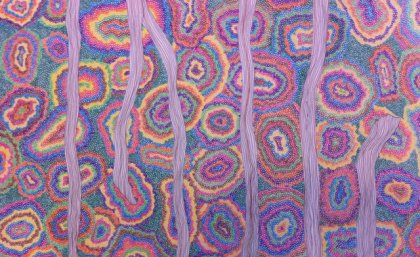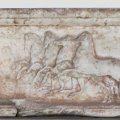
The untouched beauty of Queensland’s Idalia National Park has inspired a series of works by emerging artist Elisa Jane Carmichael, currently on display at The University of Queensland.
The works are the result of an artist-in-residence program with UQ’s School of Biological Sciences, supported by the UQ Art Museum.
Ms Carmichael, a descendant of the Quandamooka people of Moreton Bay, Queensland, was selected from a competitive field as artist-in-residence to join almost 80 UQ biological sciences students on a 2013 Outback Ecology Studies field trip.
Working across the mediums of painting, design and sculpture, Ms Carmichael’s work visually explores the beauty of nature and surrounding environments, translating her cultural connection with the land and sea.
Ms Carmichael said the Idalia National Park landscape was unfamiliar and inspiring.
“Flora, fauna and the natural environment are integral to my work, but this was my first time going out west to outback Queensland,” Ms Carmichael said.
“The residency provided a wonderful opportunity to immerse myself in an environment where I could explore a completely different aesthetic.
“Idalia National Park was totally new – every corner we turned, the landscape was different to the last. I was inspired by how much nature grows in such a dry environment.
“The main subjects of the works I produced were inspired by the aged mulga trees, dried waterholes and cave formations of the region.
“Visually, the highlight for me was Rainbow Gorge, where the colours were so vibrant. I was also really grateful to work alongside the science students and to see that world through their eyes, and I made some wonderful new friends too.”
Field trip academic coordinator and School of Biological Sciences Senior Lecturer Dr David Booth said the residency provided an opportunity for an artist to engage with UQ students and academics as they observed the park’s rare desert species and kangaroo populations and visited Emmet Pocket Lookout.
“We found this artist residency experience overwhelmingly positive for both the artist and the students, who had the chance to meet and talk to someone with a completely different perspective on life in general, and the aesthetics of the environment in particular,” Dr Booth said.
“The success of the 2013 program confirmed our ongoing commitment to run the program again in 2014, but this time in two locations: again to Idalia National Park, and for the first time to the Bunya Mountains.”
UQ Art Museum Coordinator of Academic Relations Dr Allison Holland worked closely with Dr Booth to put the pilot program in place.
“The artist-in-residency program provided a special opportunity for emerging scientists and an emerging artist to work side-by-side and gain insight into how the other perceives the environment,” Dr Holland said.
“It was a great example of how cross-disciplinary collaboration can enhance an artist’s practice and provide another dimension to the work of the students and academics involved.”
Ms Carmichael’s work can be viewed at UQ’s School of Biological Sciences, Level 3, Goddard Building (8).
Media: UQ Art Museum Media, Marketing and Communication officer Sonia Uranishi, 0409 387623, sonia@soniauranishicommunication.com; UQ Art Museum digital communications officer Sebastian Moody, +61 7 3346 8761, s.moody@uq.edu.au; Dr Allison Holland, +61 7 336 52139, a.holland1@uq.edu.au
.jpg)










